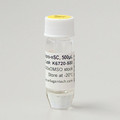 Loading... Please wait...
Loading... Please wait...- Home
- Stem Cell related
- Repro-nLS3i (1000x)
- Home
- Chemical Cocktails
- Repro-nLS3i (1000x)
Product Description
Repro-nLS3i (also named LSB3i in reference 1) contains two cocktails of total five small molecule inhibitors. According to literature1-3, the combination of these inhibitors significantly accelerated the process of deriving postmitotic neurons from human ESCs and iPSCs. Using this combination1, hESCs or hiPSCs rapidly differentiated into neurons with more than 75% efficiency within 10 days of differentiation. The resulting neurons present classical markers and functional properties of human nociceptors, including tetrodotoxin (TTX)-resistant, SCN10A-dependent sodium currents and response to nociceptive stimuli such as ATP and capsaicin1.
This differentiation process is rapid, efficient and can be easily scaled-up. Modulating cell fate of hPSC by Repro-nLS3i or similar strategies provides a method for basic stem cell research and drug discovery.
Technical information:
| Cocktail Formulation: 1000xDMSO stock solution |
Repro-nLS (K6570-500) (day 0-5) 0.1 mM of LDN193189 (BMP inhibitor), and 10 mM of SB431542 (TGF-ß1 inhibitor). Repro-n3i (K6571-500) (day 2-10) 3 mM of CHIR99021 (GSKß inhibitor), 10 mM of DAPT (Notch inhibitor), and 10 mM of SU5402 (FGFR inhibitor) |
|
| Purity: | >98% (for each compound) |
Shipping Condition: The product is shipped in a glass vial at ambient temperature.
Storage: Store DMSO solution at -20oC.
Usage: Dilute 1000x Repro-nLS stock solution at 1:1000 into your basic ESC/iPSC media. Apply it to the cells on days 0-5.
Dilute 1000x Repro-n3i stock solution in Repro-nLS3i at 1:1000 into your basic ESC/iPSC media. Apply it to the cells on days 2-10.
Reference:
| 1. | Chambers SM, et al. Combined small-molecule inhibition accelerates developmental timing and converts human pluripotent stem cells into nociceptors. Nat Biotechnol. 2012. 30(7):715-20. |
| 2. | Chambers SM, et al. Highly efficient neural conversion of human ES and iPS cells by dual inhibition of SMAD signaling. Nat Biotechnol. 2009 27(3):275-80. |
| 3. | Yu PB., et al. BMP type I receptor inhibition reduces heterotopic [corrected] ossification Nat Med. 2008. 14(12):1363-9. |
Other Information:
Product Specification (pdf)
MSDS (pdf)














